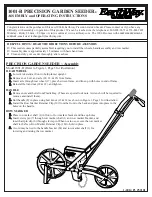
iv
SAFETY
iv
WELDING SPARKS can cause fire or explosion.
5.a. Remove fire hazards from the welding area. If this is not possible, cover them to prevent
the welding sparks from starting a fire. Remember that welding sparks and hot materials from
welding can easily go through small cracks and openings to adjacent areas. Avoid welding near
hydraulic lines. Have a fire extinguisher readily available.
5.b. Where compressed gases are to be used at the job site, special precautions should be
used to prevent hazardous
situations. Refer to “Safety in Welding and Cutting” (ANSI Standard
Z49.1) and the operating information for the Equipment being used. See
www.lincolnelectric.com.cn
for details.
5.c. When not welding, make certain no part of the electrode circuit is touching the work or
ground. Accidental contact can cause overheating and create a fire hazard.
5.d. Do not heat, cut or weld tanks, drums or containers until the proper steps have been taken
to insure that such procedures will not cause flammable or toxic vapors from substances inside.
They can cause an explosion even
though they have been “cleaned”. For information, purchase
“Recommended Safe Practices for the Preparation for Welding and Cutting of Containers and
Piping That
Have Held Hazardous Substances”, AWS F4.1 from the American Welding Society.
5.e. Vent hollow castings or containers before heating, cutting or welding. They may explode.
5.f. Sparks and spatter are thrown from the welding arc. Wear oil free protective garments such
as leather gloves, heavy shirt, cuffless trousers, high shoes and a cap over your hair. Wear ear
plugs when welding out of position or in confined places. Always wear safety glasses with side
shields when in a welding area.
5.g. Connect the work cable to the work as close to the welding area as practical. Work cables
connected to the building framework or other locations away from the welding area increase the
possibility of the welding current passing through lifting chains, crane cables or other alternate
circuits. This can create fire hazards or overheat lifting chains or cables until they fail.























